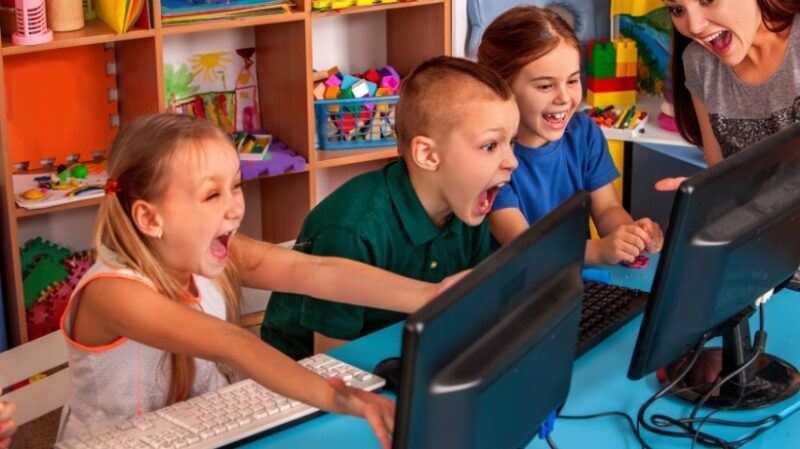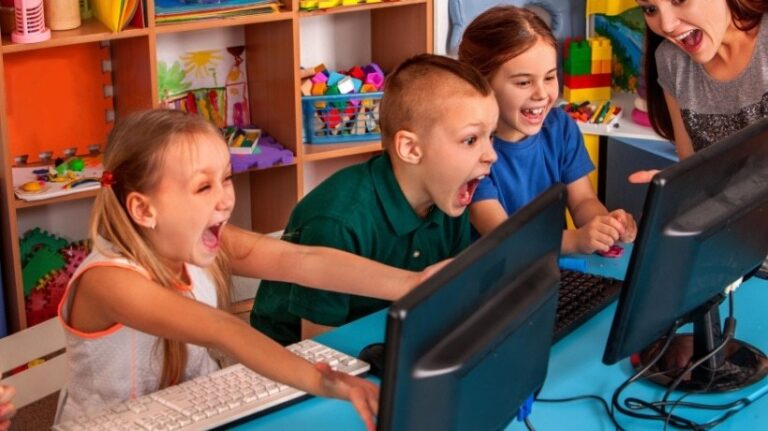
From Gamification to Gamification 2.0
You’ve probably heard of gamification, the idea of turning students into a game-like experience to make them interested. For years, educators have used gamification in simple ways, such as providing correct answer points, giving advancement badges, and ranking students on leaderboards. And although these methods worked to some extent, they often focused on exogenous motivations. In other words, students worked hard for rewards rather than learning about it themselves. This is where Gamification 2.0 steps in.
Gamification 2.0 goes beyond rewards and instead leverages what people really want to learn: curiosity, challenges and connections. Instead of earning badges, students may follow the storyline to unlock new levels that suit their progress or work with their peers to resolve issues. This kind of learning feels like playing, and science supports it. Neuroscience shows that when we are engaged in playful activities, our brains release dopamine, which not only makes us feel good, but also strengthens our memory and motivation. This means that Gamification 2.0 relies on inherent motivation, creating a lasting and rewarding learning experience. With better technology, richer storytelling, and a deeper understanding of how our brains respond to games, this new gamification approach helps students not only stay motivated, but also better retain knowledge and become more involved in the learning process. Dive in immediately and explore the science behind it and its components.
What is the science behind Gamemified Learning?
When you remember your favorite childhood moments, you’re probably thinking about playing. Whether you play board games with your family, pretend to be with friends, or solve puzzles, these times were special. You enjoyed them. Not because you had to remember the rules, but because you were having fun. This is why scientists and educators believe that play is not just for children. It’s one of the best ways to learn. But how do they back this up?
At the heart of this, there is a brain chemical called dopamine. It helps us to move, feel happy and stay motivated. Also, when we do something good, it makes us feel rewarded. Our brains release dopamine. This doesn’t just make us happy. It also helps us remember our brains better. This makes it more likely that students will forget about quizzes at school, but they remember games with friends for a long time. Positive strengthening keeps your brain on and keeps paying attention.
Dopamine is not the only evidence to support the positive effects of gamification. Two of the most effective research strategies are to extract information from memory and active recalls that involve repeating intervals that involve reviewing things over time. These strategies may seem boring in their own right, but the game takes them in without you even realizing it. For example, Duolingo uses these strategies to encourage recall words and phrases, then quickly return at the right time to enhance memory.
Finally, psychology also supports gamification. Learning is not just about memory. It’s also about how you feel while studying. The game creates a safe space that is not ashamed of mistakes and is part of the process. When students see failure as an opportunity to try something new, they become more curious, creative and strong.
Five key elements of gamification 2.0
1. Storytelling
Gamification 2.0 shows that learning can be more meaningful when it is part of a compelling story. Think about your favorite childhood games and books you loved. Perhaps it was special to you because there was a story. This is because our brains remember the story better than the facts. With Gamification 2.0, storytelling allows you to learn more than just a mountain of tasks. Instead of saying, “Today I’m solving ten math problems,” for example, teachers can turn the story of students finding hidden treasure chests, which are explorers. As such, mathematics problems become an exciting challenge for adventure.
Here’s why this approach works:
The story provides context and allows students to see why they are learning. They create emotional connections, so students care about the characters and what happens. They stimulate curiosity. It’s fascinating because students want to know what happens next.
2. Adaptation challenges
One of the major challenges in the classroom is that students learn at different speeds. Other children get things easily and get bored and bored, while others find it difficult to catch up when it gets difficult and get frustrated. Gamification 2.0 uses adaptive challenges that are excluded directly from the game to fix this. At the start of the game, the levels are easy so you can learn. As you get better, your levels become more difficult and you will continue to be interested without being overwhelmed. Similarly, in schools, adaptive tasks mean that teachers or LMSs change difficulty based on what students are doing well. If students answer questions quickly, they become difficult. If they struggle, they will receive easier questions and tips until they can move on.
3. Balance between competition and collaboration
For many people, the game is about playing with others. Whether you work with friends or compete in a friendly way, the social part of the game will make them fun and memorable. Gamification 2.0 brings the same ideas to the classroom. It focuses on balance of teamwork and friendly competition. How does it work? First, collaboration. Students work together to solve problems, complete tasks, and achieve common goals. This helps them learn from each other and build teamwork skills. Then, in a healthy competition. Instead of punishing those who can’t win, competition is used to motivate them. For example, a team may compete to finish a puzzle, but everyone celebrates when the entire class is successful. The main point of Gamification 2.0 is balance. Students experience the fun of competition without the stress of winning or losing. They also enjoy the satisfaction of working with something bigger.
4. feedback
Feedback keeps the game interesting. Feedback means the way the game responds to you when you take action. The feedback loop works the same way with learning. Thankfully, Gamification 2.0 will help students respond instantly. If they answer correctly, they will unlock the next assignment. If they answered incorrectly, they can either receive a hint or try again immediately. Complete the module and you will either increase your progress or earn a new badge. This helps students understand where they stand and reduce the fear of failure as mistakes are only part of the learning process. Gamification 2.0 uses feedback to not only evaluate learning, but also guide learning. This is what students are involved, motivated and constantly improving.
5. Autonomy
One of the best parts of the game is freedom. Players can choose a character, path, or how to resolve the issue. This sense of control makes the experience personal and enjoyable. Instead of all students following the same rigorous path, a gamification platform allows you to choose the type of assessment, such as the first challenge to tackle, topics to explore, and even quizzes, projects, presentations, and more. Even small choices can make a huge difference. For example, allowing students to choose between two tasks can improve engagement. Both options help you achieve the same learning goals, but students feel they are in control of their learning journey. Why is choice important? They pay more attention to students when they feel ownership, and motivate students to care more and build independence, as learners take charge of their progress and finally respect individuality. Not all students learn the same way, so choices make learning more comprehensive.
Conclusion
When learning feels like play, students don’t just get a better understanding of concepts. They actually remember them, use them and enjoy the process. That’s the power of Gamification 2.0. It’s not about handing out points and badges, it’s about creating meaningful experiences that stimulate curiosity and build true skills. If you want to keep up with today’s world, you need to make it attractive, adaptable and enjoyable. It embraces Gamification 2.0, gives students the opportunity to learn in a way that inspires them and prepares them for lifelong learning.


